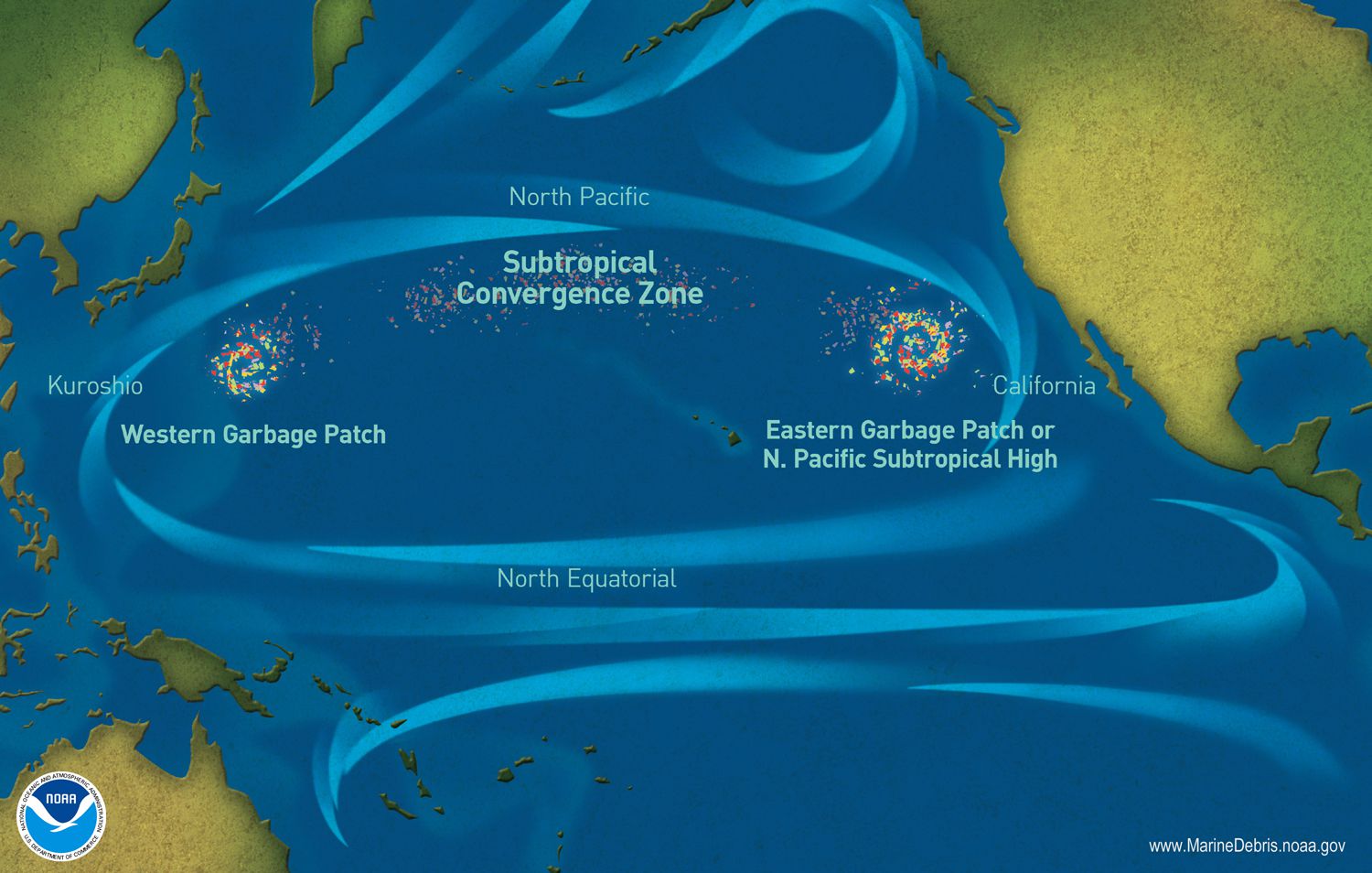As I will describe below this “Patch” causes harm to many types of critters.
The Patch is actually two patches:
 Quote:
Quote:The Great Pacific Garbage Patch is a collection of marine debris in the North Pacific Ocean. Also known as the Pacific trash vortex, the garbage patch is actually two distinct collections of debris bounded by the massive North Pacific Subtropical Gyre. . . .
The Great Pacific Garbage Patch, also known as the Pacific trash vortex, spans waters from the West Coast of North America to Japan. The patch is actually comprised of the Western Garbage Patch, located near Japan, and the Eastern Garbage Patch, located between the U.S. states of Hawaii and California.
These areas of spinning debris are linked together by the North Pacific Subtropical Convergence Zone, located a few hundred kilometers north of Hawaii. This convergence zone is where warm water from the South Pacific meets up with cooler water from the Arctic. The zone acts like a highway that moves debris from one patch to another.
The entire Great Pacific Garbage Patch is bounded by the North Pacific Subtropical Gyre. The National Oceanic and Atmospheric Administration (NOAA) defines a gyre as a large system of swirling ocean currents. Increasingly, however, it also refers to the garbage patch as a vortex of plastic waste and debris broken down into small particles in the ocean. The North Pacific Subtropical Gyre is formed by four currents rotating clockwise around an area of 20 million square kilometers (7.7 million square miles): the California current, the North Equatorial current, the Kuroshio current, and the North Pacific current.
The area in the center of a gyre tends to be very calm and stable. The circular motion of the gyre draws debris into this stable center, where it becomes trapped. A plastic water bottle discarded off the coast of California, for instance, takes the California Current south toward Mexico. There, it may catch the North Equatorial Current, which crosses the vast Pacific. Near the coast of Japan, the bottle may travel north on the powerful Kuroshiro Current. Finally, the bottle travels eastward on the North Pacific Current. The gently rolling vortexes of the Eastern and Western Garbage Patches gradually draw in the bottle.
The material in the patch is not in the shape of bottles, bottle caps etc but in the form of
microplastics. . . .In reality, these patches are almost entirely made up of tiny bits of plastic, called microplastics. Microplastics can’t always be seen by the naked eye. Even satellite imagery doesn’t show a giant patch of garbage. The microplastics of the Great Pacific Garbage Patch can simply make the water look like a cloudy soup. This soup is intermixed with larger items, such as fishing gear and shoes.
The seafloor beneath the Great Pacific Garbage Patch may also be an underwater trash heap. Oceanographers and ecologists recently discovered that about 70% of marine debris actually sinks to the bottom of the ocean.
While oceanographers and climatologists predicted the existence of the Great Pacific Garbage Patch, it was a racing boat captain by the name of Charles Moore who actually discovered the trash vortex. Moore was sailing from Hawaii to California after competing in a yachting race. Crossing the North Pacific Subtropical Gyre, Moore and his crew noticed millions of pieces of plastic surrounding his ship.
Marine Debris
No one knows how much debris makes up the Great Pacific Garbage Patch. The North Pacific Subtropical Gyre is too large for scientists to trawl. In addition, not all of the trash floats on the surface. Denser debris can sink centimeters or even several meters beneath the surface, making the vortex’s area nearly impossible to measure.
80 percent of plastic in the ocean is estimated to come from land-based sources, with the remaining 20 percent coming from boats and other marine sources. These percentages vary by region, however. A 2018 study found that synthetic fishing nets made up nearly half the mass of the Great Pacific Garbage Patch, due largely to ocean current dynamics and increased fishing activity in the Pacific Ocean.
While many different types of trash enter the ocean, plastics make up the majority of marine debris for two reasons. First, plastic’s durability, low cost, and malleability mean that it’s being used in more and more consumer and industrial products. Second, plastic goods do not biodegrade but instead, break down into smaller pieces.
In the ocean, the sun breaks down these plastics into tinier and tinier pieces, a process known as photodegradation. Most of this debris comes from plastic bags, bottle caps, plastic water bottles, and Styrofoam cups. [/quote]
https://www.nationalgeographic.org/encyclopedia/great-pacific-garbage-patch/The Nat. Geographic article is clear and easy to read. Now to get on to the harm to critters part of that article.

 Forum
Forum

 Home
Home 

 Album
Album 

 Help
Help

 Search
Search

 Recent
Recent 

 Rules
Rules 

 Login
Login

 Register
Register





 Pages: 1
Pages: 1 

